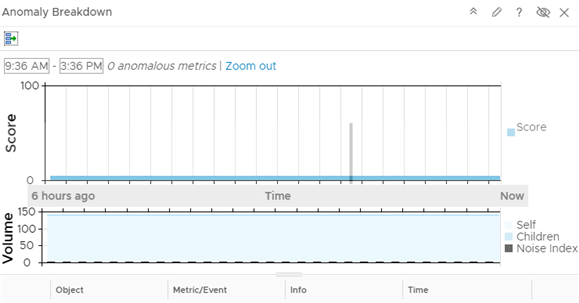The Anomaly Breakdown widget shows the likely root causes for symptoms for a selected resource.
How the Anomaly Breakdown Widget and Configuration Options Work

You can add the Anomaly Breakdown widget to one or more custom dashboards and configure it to display data that is important to the dashboard users.
Where You Find the Anomaly Breakdown Widget
The widget might be included on any of your custom dashboards. From the left menu, click to see your configured dashboards.
To customize the data that appears in the dashboard widget, from the left menu, click . To create your dashboard, from the left menu, click . From the Dashboards panel, click Create. To edit your dashboard, from the left menu, click . From the Dashboards panel, select the dashboard you want to edit and select . Toggle between the Views and Widgets option to view and add a widget or view to the dashboard. The widgets list panel displays a list of all the predefined widgets. Drag a widget to the dashboard workspace in the upper panel.
Anomaly Breakdown Widget Display Options
The Anomaly Breakdown widget displays scores, volume, and a list of anomaly metrics.
| Option | Description |
|---|---|
| Score | Anomaly value. |
| Volume | VMware Aria Operations full set metric count for the selected object in the specified time range. |
| Anomaly Metrics List | List of alarms for the selected object in the specified time range. |
Anomaly Breakdown Widget Toolbar Options
On the title bar of the widget, click the Show Toolbar icon to access the toolbar options.
| Option | Description |
|---|---|
| Show Bar Details | If the widget is displaying data for multiple objects, you can select a row and click this button to view the list of alarms for the selected object. |
| Perform Multiple Interaction | If the widget is a provider for another widget on the dashboard, you can select multiple rows and click this button. The receiving widget then displays only the data related to the selected interaction items. Use Ctrl+click for Windows, or Cmd+click for Mac OS X, to select multiple individual objects or Shift+click to select a range of objects, and click the icon to activate the interaction. |
Anomaly Breakdown Widget Configuration Options
On the title bar of the widget, click the Edit Widget icon to configure the widget.
The configuration options are grouped into one or more sections. You can select the objects on which you want to base the widget data and refine the objects in the following sections. Each section filters the objects further and pushes the filtered objects to the next section. The widget data is based on the objects that are the output of the last section.
The Configuration section provides general configuration options for the widget.
The Input Data section provides options to specify input for the widget. This section appears when the widget is in self provider mode.
The Output Filter section provides options to restrict the widget data based on the selected filter criteria.
| Option | Description |
|---|---|
| Title | Enter a custom title that identifies this widget from other instances that are based on the same widget template. |
| Configuration | |
| Refresh Content | Activate or deactivate the automatic refreshing of the data in this widget. If not activated, the widget is updated only when the dashboard is opened or when you click the Refresh button on the widget in the dashboard. |
| Refresh Interval | If you activate the Refresh Content option, specify how often to refresh the data in this widget. |
| Self Provider |
Indicates whether the objects for which data appears in the widget are defined in the widget or provided by another widget.
|
| Mode | Display a single object or multiple objects. |
| Show | Select the number of objects to display in multiple objects mode. |
| Input Data | |
| Object | Search for objects in your environment and select the object on which you are basing the widget data. You can also click the Add Object icon and select an object from the object list. You can use the Filter text box to refine the object list and the Tag Filter pane to select an object based on tag values. |
| Output Filter | |
| Basic |
Pick tags to refine the widget data. The widget data is based on the objects that have the picked tags applied. If you pick more than one value for the same tag, the widget includes objects that have any of the tags applied. If you pick more than one value for different tags, the widget includes only the objects that have all the tags applied. |